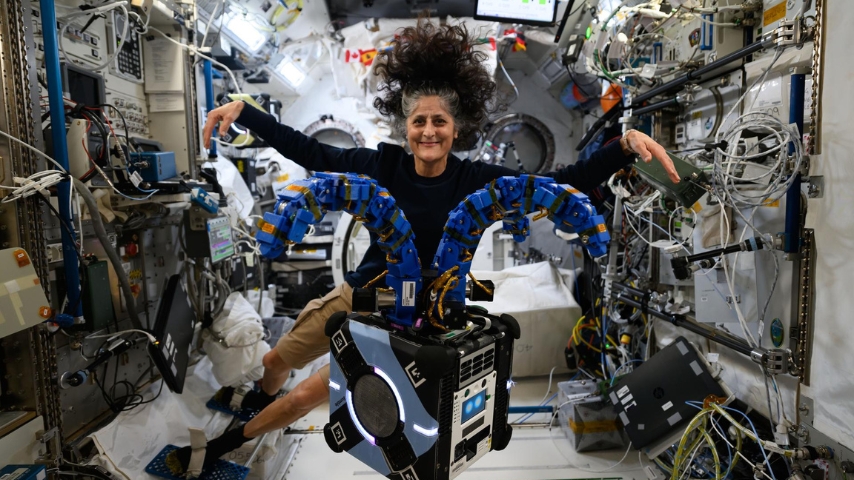Blog: Resupply, Recovery, and Removal are Part of LEO Life
Blog: Resupply, Recovery, and Removal are Part of LEO Life


Amid module mishaps and scientific investigations, life on the International Space Station includes the resupply of food, the recovery of water, and the removal of household garbage.
The ongoing effort to resupply those on the low-earth orbit (LEO) laboratory with what is needed for human life, including food and other consumables is not out of the headlines yet. The pressurized cargo module on the Cygnus spacecraft for Northrop Grumman’s 22nd Commercial Resupply Services mission was damaged on its way from Europe, reported the ISS National Laboratory.
This “heavy equipment incident” has caused the cancellation of the International Space Station’s (ISS) resupply mission scheduled for June, reported Dan Maloney for Hackaday. The website for engineers and engineering enthusiasts reported that, “whatever had damaged the container [containing the module] had also damaged the spacecraft.” To deal with the problem of crew running low on consumables in the meantime, the next scheduled resupply mission, a SpaceX Cargo Dragon launch slated for this month will carry more than what was originally planned.
Astronauts and cosmonauts continuously occupy the ISS and basic necessities for life—air, water, and food—have to be either regularly shipped from Earth or recycled by the station itself. For example, according to NASA, each day each crew member requires at least one gallon of water for drinking, food preparation, and hygiene. Engineers have made it possible for the station to recover about 51 percent of oxygen from carbon dioxide, and more than 90 percent of water with work underway to increase these margins.
Currently, NASA works with two companies to resupply the ISS. The American SpaceX and Orbital ATK (now Northrop Grumman) began two years after the end of the Space Shuttle program to resupply the space station with materials from the United States. The commercial contracts require transportation to and from the space laboratory of at least 20 metric tons of cargo. And other international space agencies also supply the space station.
At the beginning of this year Russia launched the Progress MS-30 cargo spacecraft into orbit using a Soyuz-2.1a rocket. It lifted off from Baikonur Cosmodrome in Kazakhstan and took two days to reach the space laboratory carrying 2,599 kilograms of cargo, including 1,179 kilograms of equipment, clothing, food supplies, as well as medical and hygiene products. Additionally, the spacecraft transported 950 kilograms of fuel for station refueling, 420 liters of drinking water, and 50 kilograms of nitrogen to replenish the station’s atmosphere, reported Roscosmos.
But deliveries are not always toilet paper and bandages. Back in 2001, the Russians delivered a pizza with a 30-foot long Pizza Hut logo adorning the world’s largest proton Russian rocket, reported Chowhound. “The Russian resupply team spent several months creating the recipe in the Baikonur Cosmodrome kitchen to ensure that it could withstand space travel, and the resulting product was indeed cheesy with a crispy thin crust and red sauce,” the food website declared.
Of course, what goes up must come down and the space station has to eventually deal with household waste. The Cargo Dragons are reuseable, but the Cygnus cargo modules are expendable, which makes them perfect to dispose of the trash produced by the long-duration ISS crew. Modules filled with garbage burn upon reentry. But the earliest a Cygnus is scheduled to dock at the ISS again is sometime this fall, which may make for a long summer for the current crew.
As a member of NASA’s Commercial Crew program, Sunita "Suni" Williams made headlines recently as she and Butch Wilmore spent nine months in space. The pair launched from the Kennedy Space Center in Florida on June 5, 2024, to co-pilot the Boeing Starliner for its first crewed spaceflight to orbit. But the Boeing spacecraft developed problems that included helium leaks and propulsion issues. They returned to Earth on March 18, 2025, as part of the ninth rotational SpaceX crew mission (Crew-9).
Williams spent that time productively devoted to science and now holds the distinction of her total spacewalk time of 62 hours and 6 minutes being the most by a woman and, among individuals who have been in space, fourth overall. So how does Williams feel making space history? "Records are there for breaking," she told ASME back in 2013 well before her latest ISS journey.
Among the scientific projects the crew worked on during their mission was one that supports advanced technology for manufacturing in space. Withing the ISS’s persistent microgravity, Bristol Myers Squibb and Redwire Space seek to study model small molecule compounds that are often larger, more well-ordered, and could have improved morphology (geometric shape) than those grown on Earth.
Cathy Cecere is membership content program manager.
This “heavy equipment incident” has caused the cancellation of the International Space Station’s (ISS) resupply mission scheduled for June, reported Dan Maloney for Hackaday. The website for engineers and engineering enthusiasts reported that, “whatever had damaged the container [containing the module] had also damaged the spacecraft.” To deal with the problem of crew running low on consumables in the meantime, the next scheduled resupply mission, a SpaceX Cargo Dragon launch slated for this month will carry more than what was originally planned.
Astronauts and cosmonauts continuously occupy the ISS and basic necessities for life—air, water, and food—have to be either regularly shipped from Earth or recycled by the station itself. For example, according to NASA, each day each crew member requires at least one gallon of water for drinking, food preparation, and hygiene. Engineers have made it possible for the station to recover about 51 percent of oxygen from carbon dioxide, and more than 90 percent of water with work underway to increase these margins.
Currently, NASA works with two companies to resupply the ISS. The American SpaceX and Orbital ATK (now Northrop Grumman) began two years after the end of the Space Shuttle program to resupply the space station with materials from the United States. The commercial contracts require transportation to and from the space laboratory of at least 20 metric tons of cargo. And other international space agencies also supply the space station.
At the beginning of this year Russia launched the Progress MS-30 cargo spacecraft into orbit using a Soyuz-2.1a rocket. It lifted off from Baikonur Cosmodrome in Kazakhstan and took two days to reach the space laboratory carrying 2,599 kilograms of cargo, including 1,179 kilograms of equipment, clothing, food supplies, as well as medical and hygiene products. Additionally, the spacecraft transported 950 kilograms of fuel for station refueling, 420 liters of drinking water, and 50 kilograms of nitrogen to replenish the station’s atmosphere, reported Roscosmos.
But deliveries are not always toilet paper and bandages. Back in 2001, the Russians delivered a pizza with a 30-foot long Pizza Hut logo adorning the world’s largest proton Russian rocket, reported Chowhound. “The Russian resupply team spent several months creating the recipe in the Baikonur Cosmodrome kitchen to ensure that it could withstand space travel, and the resulting product was indeed cheesy with a crispy thin crust and red sauce,” the food website declared.
Of course, what goes up must come down and the space station has to eventually deal with household waste. The Cargo Dragons are reuseable, but the Cygnus cargo modules are expendable, which makes them perfect to dispose of the trash produced by the long-duration ISS crew. Modules filled with garbage burn upon reentry. But the earliest a Cygnus is scheduled to dock at the ISS again is sometime this fall, which may make for a long summer for the current crew.
As a member of NASA’s Commercial Crew program, Sunita "Suni" Williams made headlines recently as she and Butch Wilmore spent nine months in space. The pair launched from the Kennedy Space Center in Florida on June 5, 2024, to co-pilot the Boeing Starliner for its first crewed spaceflight to orbit. But the Boeing spacecraft developed problems that included helium leaks and propulsion issues. They returned to Earth on March 18, 2025, as part of the ninth rotational SpaceX crew mission (Crew-9).
Williams spent that time productively devoted to science and now holds the distinction of her total spacewalk time of 62 hours and 6 minutes being the most by a woman and, among individuals who have been in space, fourth overall. So how does Williams feel making space history? "Records are there for breaking," she told ASME back in 2013 well before her latest ISS journey.
Among the scientific projects the crew worked on during their mission was one that supports advanced technology for manufacturing in space. Withing the ISS’s persistent microgravity, Bristol Myers Squibb and Redwire Space seek to study model small molecule compounds that are often larger, more well-ordered, and could have improved morphology (geometric shape) than those grown on Earth.
Cathy Cecere is membership content program manager.




